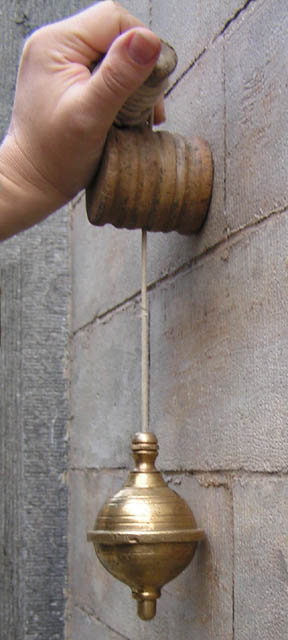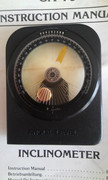a33
Digital-Forum Master
Spesso mi sono imbattuto nell'affermazione che il palo di una parabola satellitare dovrebbe essere assolutamente a piombo ("a bolla"), soprattutto quando si tratta di una parabola multifeed o di una parabola motorizzata.
Ad esempio, in questo argomento recente, è stato menzionato: https://www.digital-forum.it/thread...-e-configurazione.221223/page-20#post-8149398
Quindi ho pensato di aprire un thread separato per questo.
Se deve essere assolutamente a piombo, ci deve essere un problema definitivo e irreparabile se non è a piombo, ho pensato. Quindi in passato, ho pensato un po' a questa domanda.
La mia conclusione è in fondo a questo post.
I problemi che si presentano per un piatto a singolo feed o multifeed con un palo non a piombo sono, credo:
- la scala di elevazione non corrisponde più e la direzione dell'azimut è più difficile da trovare, quindi trovare un satellite è più difficile;
- quando hai trovato un satellite vicino (ad esempio: 19E) e vuoi trovare 13E, la regolazione non è solo in una dimensione (lateralmente), ma in due dimensioni, il che lo rende più difficile.
Hanno conseguenze irreparabili? No, non credo.
La procedura di messa a punto, una volta trovato il segnale, sarebbe esattamente la stessa. Cerchi di modificare un po' una dimensione e l'altra dimensione e puoi quindi trovare il segnale massimo.
Per un parabola motorizzato, gli effetti della non-piombicità sono un po' diversi.
La non-piombicità in senso nord/sud può essere completamente riparata/contrastata con l'angolo di elevazione del motore rispetto al palo. Quindi non ci sono problemi con la non-piombicità in senso nord/sud.
Tuttavia, la verticalità est/ovest è l'unico modo per ottenere un seguito simmetrico dell'arco, quindi lo consiglierei sicuramente.
Anche se per la non verticalità est/ovest, ci sono metodi per ottenere comunque una soluzione soddisfacente. Pensa alla procedura per l'Arc-Set di Gourmet... Entertaining (Jim Roberts) e ai disegni per la messa a punto delle configurazioni del motore (due correzioni, per la mira errata del punto più alto).
In questo modo, l'arco può essere seguito in modo soddisfacente, ma non esattamente simmetrico attorno al punto più alto.
La mia conclusione è: un palo a piombo può certamente semplificare le cose rispetto a un palo non a piombo, ma non è indispensabile.
Solo per le configurazioni motorizzate, si consiglia un palo a piombo est/ovest.
Quindi penso che dire in generale che un palo deve essere a piombo sia sbagliato. È comodo, ma non necessario.
Tradotto da:
Often I came across the statement, that the pole for a satellite dish should be absolutely plumb ("a bolla"), especially when it concerns a multifeed dish, or a motorized dish.
For instance in this recent topic, it was mentioned: https://www.digital-forum.it/thread...-e-configurazione.221223/page-20#post-8149398
So I thought that I would open a separate thread for it.
If it must absolutely be plumb, there must be a definite, irrepairable problem if it is not plumb, I thought. So in the past, I have thought a bit about this question.
My conclusion is at the bottom of this post.
The problems that arise for a single feed or multifeed dish with a non-plumb pole are, I believe:
- the elevation scale is not matching anymore, and the azimuth direction is harder to find, so for finding a satellite this is more difficult;
- when you have found a neighbouring satellite (say: 19E) and want to find 13E, the adjustment is not just in one dimension (sideways), but in two dimensions, which make it more difficult.
Do they have irrepairable consequences? No, I don't think so.
The finetuning procedure, once you have found the signal, would be exactly the same. You try to alter the one dimension a bit, and the other dimension, and you can thus find maximum signal.
For a motorized dish, the effects of non-plumbness are a bit different.
Non-plumbness north/south-wise can be fully counteracted with the motor elevation angle against the pole. So there is no problem with north/south-wise non-plumbness.
Plumbness east/west-wise however is the only way, to get a symmetrical following of the arc, so that I would definitely advice.
Though for non-plumbness east/west-wise, there are methods to get still a satisfactory solution. Think of the procedure for the Arc-Set from Gourmet... Entertaining (Jim Roberts), and the drawings for finetuning motor setups (two corrections, for incorrect highest point aiming).
That way, the arc may be followed satisfactorilly, but not exactly symmetrical around the highest pont anymore.
My conclusion is: A plumb mast can certainly make things easier, than a non-plumb mast, but is not imperative.
Only for motorized setups, an east/west-wise plumb mast is adviced.
So I think to generally say that a mast must be plumb, is incorrect. It is convenient, but not necessary.
Ciao,
A33
Ad esempio, in questo argomento recente, è stato menzionato: https://www.digital-forum.it/thread...-e-configurazione.221223/page-20#post-8149398
Quindi ho pensato di aprire un thread separato per questo.
Se deve essere assolutamente a piombo, ci deve essere un problema definitivo e irreparabile se non è a piombo, ho pensato. Quindi in passato, ho pensato un po' a questa domanda.
La mia conclusione è in fondo a questo post.
I problemi che si presentano per un piatto a singolo feed o multifeed con un palo non a piombo sono, credo:
- la scala di elevazione non corrisponde più e la direzione dell'azimut è più difficile da trovare, quindi trovare un satellite è più difficile;
- quando hai trovato un satellite vicino (ad esempio: 19E) e vuoi trovare 13E, la regolazione non è solo in una dimensione (lateralmente), ma in due dimensioni, il che lo rende più difficile.
Hanno conseguenze irreparabili? No, non credo.
La procedura di messa a punto, una volta trovato il segnale, sarebbe esattamente la stessa. Cerchi di modificare un po' una dimensione e l'altra dimensione e puoi quindi trovare il segnale massimo.
Per un parabola motorizzato, gli effetti della non-piombicità sono un po' diversi.
La non-piombicità in senso nord/sud può essere completamente riparata/contrastata con l'angolo di elevazione del motore rispetto al palo. Quindi non ci sono problemi con la non-piombicità in senso nord/sud.
Tuttavia, la verticalità est/ovest è l'unico modo per ottenere un seguito simmetrico dell'arco, quindi lo consiglierei sicuramente.
Anche se per la non verticalità est/ovest, ci sono metodi per ottenere comunque una soluzione soddisfacente. Pensa alla procedura per l'Arc-Set di Gourmet... Entertaining (Jim Roberts) e ai disegni per la messa a punto delle configurazioni del motore (due correzioni, per la mira errata del punto più alto).
In questo modo, l'arco può essere seguito in modo soddisfacente, ma non esattamente simmetrico attorno al punto più alto.
La mia conclusione è: un palo a piombo può certamente semplificare le cose rispetto a un palo non a piombo, ma non è indispensabile.
Solo per le configurazioni motorizzate, si consiglia un palo a piombo est/ovest.
Quindi penso che dire in generale che un palo deve essere a piombo sia sbagliato. È comodo, ma non necessario.
Tradotto da:
Often I came across the statement, that the pole for a satellite dish should be absolutely plumb ("a bolla"), especially when it concerns a multifeed dish, or a motorized dish.
For instance in this recent topic, it was mentioned: https://www.digital-forum.it/thread...-e-configurazione.221223/page-20#post-8149398
So I thought that I would open a separate thread for it.
If it must absolutely be plumb, there must be a definite, irrepairable problem if it is not plumb, I thought. So in the past, I have thought a bit about this question.
My conclusion is at the bottom of this post.
The problems that arise for a single feed or multifeed dish with a non-plumb pole are, I believe:
- the elevation scale is not matching anymore, and the azimuth direction is harder to find, so for finding a satellite this is more difficult;
- when you have found a neighbouring satellite (say: 19E) and want to find 13E, the adjustment is not just in one dimension (sideways), but in two dimensions, which make it more difficult.
Do they have irrepairable consequences? No, I don't think so.
The finetuning procedure, once you have found the signal, would be exactly the same. You try to alter the one dimension a bit, and the other dimension, and you can thus find maximum signal.
For a motorized dish, the effects of non-plumbness are a bit different.
Non-plumbness north/south-wise can be fully counteracted with the motor elevation angle against the pole. So there is no problem with north/south-wise non-plumbness.
Plumbness east/west-wise however is the only way, to get a symmetrical following of the arc, so that I would definitely advice.
Though for non-plumbness east/west-wise, there are methods to get still a satisfactory solution. Think of the procedure for the Arc-Set from Gourmet... Entertaining (Jim Roberts), and the drawings for finetuning motor setups (two corrections, for incorrect highest point aiming).
That way, the arc may be followed satisfactorilly, but not exactly symmetrical around the highest pont anymore.
My conclusion is: A plumb mast can certainly make things easier, than a non-plumb mast, but is not imperative.
Only for motorized setups, an east/west-wise plumb mast is adviced.
So I think to generally say that a mast must be plumb, is incorrect. It is convenient, but not necessary.
Ciao,
A33



